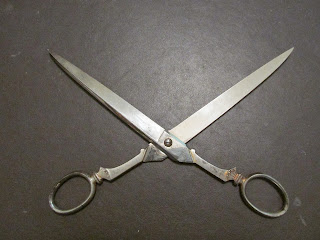Schnefel Brothers opened a cutlery distributorship in
Newark, New Jersey in 1909. They were
located at 648-686 South 17th Street. Their products appear to have come from
Germany and included a wide range of scissors, nail clippers, straight razors,
and other items. They operated at the
New Jersey address until 1928. (Goin’s
Encyclopedia of Cutlery Markings)
According to a filing with the U.S. federal trademark
organization the Schnefel Brothers Inc. filed for a brand trademark called “LaCross”
on September 9, 1930. This trademark
included tweezers for dental, surgical, manicure items, emery boards, and
blackhead/pimple removers.
 |
| Artistic Handles |
My friend, Pat, a retired school teacher from California,
had me sharpen these scissors which were sold by the Schnefel Brothers. They belonged to her grandfather, James
Liska. James and his brother, Will
Liska, were California tailors who came from Czechoslovakia. The “Liska Bros. Better Tailoring” shop was
on Vermont Street in Los Angeles. These scissors are extra long and would have been used to cut in ways that we use rotary cutters today. Notice the artful looking handles. Some of this style of scissor would be used in offices as well and would have a letter opener as part of the set.

The large shear was also used in the Liska Bros. tailor shop. They are unmarked, but a
work of
art in themselves. Notice the handles
are formed to fit the hand and permit maximum cutting power. Many of the very early handmade American
tailor scissors were designed in a similar fashion.
Cutting fabric all day, every day, in a tailor shop when
most men wore individually crafted suits required a scissor design that would
make the work more comfortable. In this particular story both the tool
manufacturer and the end-user were American immigrants whose skill
craftsmanship helped build this country!












































